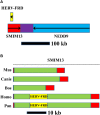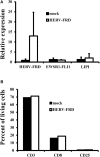Investigation of Endogenous Retrovirus Sequences in the Neighborhood of Genes Up-regulated in a Neuroblastoma Model after Treatment with Hypoxia-Mimetic Cobalt Chloride
- PMID: 29515560
- PMCID: PMC5826361
- DOI: 10.3389/fmicb.2018.00287
Investigation of Endogenous Retrovirus Sequences in the Neighborhood of Genes Up-regulated in a Neuroblastoma Model after Treatment with Hypoxia-Mimetic Cobalt Chloride
Abstract
Human endogenous retroviruses (ERVs) have been found to be associated with different diseases, e.g., multiple sclerosis (MS). Most human ERVs integrated in our genome are not competent to replicate and these sequences are presumably silent. However, transcription of human ERVs can be reactivated, e.g., by hypoxia. Interestingly, MS has been linked to hypoxia since decades. As some patterns of demyelination are similar to white matter ischemia, hypoxic damage is discussed. Therefore, we are interested in the association between hypoxia and ERVs. As a model, we used human SH-SY5Y neuroblastoma cells after treatment with the hypoxia-mimetic cobalt chloride and analyzed differences in the gene expression profiles in comparison to untreated cells. The vicinity of up-regulated genes was scanned for endogenous retrovirus-derived sequences. Five genes were found to be strongly up-regulated in SH-SY5Y cells after treatment with cobalt chloride: clusterin, glutathione peroxidase 3, insulin-like growth factor 2, solute carrier family 7 member 11, and neural precursor cell expressed developmentally down-regulated protein 9. In the vicinity of these genes we identified large (>1,000 bp) open reading frames (ORFs). Most of these ORFs showed only low similarities to proteins from retro-transcribing viruses. However, we found very high similarity between retrovirus envelope sequences and a sequence in the vicinity of neural precursor cell expressed developmentally down-regulated protein 9. This sequence encodes the human endogenous retrovirus group FRD member 1, the encoded protein product is called syncytin 2. Transfection of syncytin 2 into the well-characterized Ewing sarcoma cell line A673 was not able to modulate the low immunostimulatory activity of this cell line. Future research is needed to determine whether the identified genes and the human endogenous retrovirus group FRD member 1 might play a role in the etiology of MS.
Keywords: ERVFRD-1; HERV-FRD; endogenous retroviruses; human endogenous retrovirus group FRD member 1; hypoxia; multiple sclerosis; neural precursor cell expressed developmentally down-regulated protein 9 (NEDD9); open reading frames.
Figures




Similar articles
-
A survey of endogenous retrovirus (ERV) sequences in the vicinity of multiple sclerosis (MS)-associated single nucleotide polymorphisms (SNPs).Mol Biol Rep. 2016 Aug;43(8):827-36. doi: 10.1007/s11033-016-4004-0. Epub 2016 May 12. Mol Biol Rep. 2016. PMID: 27169423
-
Identification of endogenous retroviral reading frames in the human genome.Retrovirology. 2004 Oct 11;1:32. doi: 10.1186/1742-4690-1-32. Retrovirology. 2004. PMID: 15476554 Free PMC article.
-
Human endogenous retrovirus W in brain lesions: Rationale for targeted therapy in multiple sclerosis.Mult Scler Relat Disord. 2016 Jul;8:11-8. doi: 10.1016/j.msard.2016.04.006. Epub 2016 Apr 22. Mult Scler Relat Disord. 2016. PMID: 27456869
-
Endogenous retroviruses and MS: using ERVs as disease markers.Int MS J. 2003 Apr;10(1):22-8. Int MS J. 2003. PMID: 12906767 Review.
-
Human Endogenous Retroviral Envelope Protein Syncytin-1 and Inflammatory Abnormalities in Neuropsychological Diseases.Front Psychiatry. 2018 Sep 7;9:422. doi: 10.3389/fpsyt.2018.00422. eCollection 2018. Front Psychiatry. 2018. PMID: 30245643 Free PMC article. Review.
Cited by
-
Molecular Aspects of Hypoxic Stress Effects in Chronic Ethanol Exposure of Neuronal Cells.Curr Issues Mol Biol. 2023 Feb 16;45(2):1655-1680. doi: 10.3390/cimb45020107. Curr Issues Mol Biol. 2023. PMID: 36826052 Free PMC article.
-
Activation of Endogenous Retrovirus, Brain Infections and Environmental Insults in Neurodegeneration and Alzheimer's Disease.Int J Mol Sci. 2021 Jul 6;22(14):7263. doi: 10.3390/ijms22147263. Int J Mol Sci. 2021. PMID: 34298881 Free PMC article. Review.
-
Mechanisms involved in selecting and maintaining neuroblastoma cancer stem cell populations, and perspectives for therapeutic targeting.World J Stem Cells. 2021 Jul 26;13(7):685-736. doi: 10.4252/wjsc.v13.i7.685. World J Stem Cells. 2021. PMID: 34367474 Free PMC article. Review.
-
Pathophysiological significance and modulation of the transient receptor potential canonical 3 ion channel.Med Res Rev. 2024 Nov;44(6):2510-2544. doi: 10.1002/med.22048. Epub 2024 May 7. Med Res Rev. 2024. PMID: 38715347 Review.
-
HIF regulates multiple translated endogenous retroviruses: Implications for cancer immunotherapy.Cell. 2025 Apr 3;188(7):1807-1827.e34. doi: 10.1016/j.cell.2025.01.046. Epub 2025 Feb 28. Cell. 2025. PMID: 40023154 Free PMC article.
References
-
- Auer R. N., Rowlands C. G., Perry S. F., Remmers J. E. (1995). Multiple sclerosis with medullary plaques and fatal sleep apnea (Ondine’s curse). Clin. Neuropathol. 15 101–105. - PubMed
LinkOut - more resources
Full Text Sources
Other Literature Sources
Molecular Biology Databases
Research Materials

